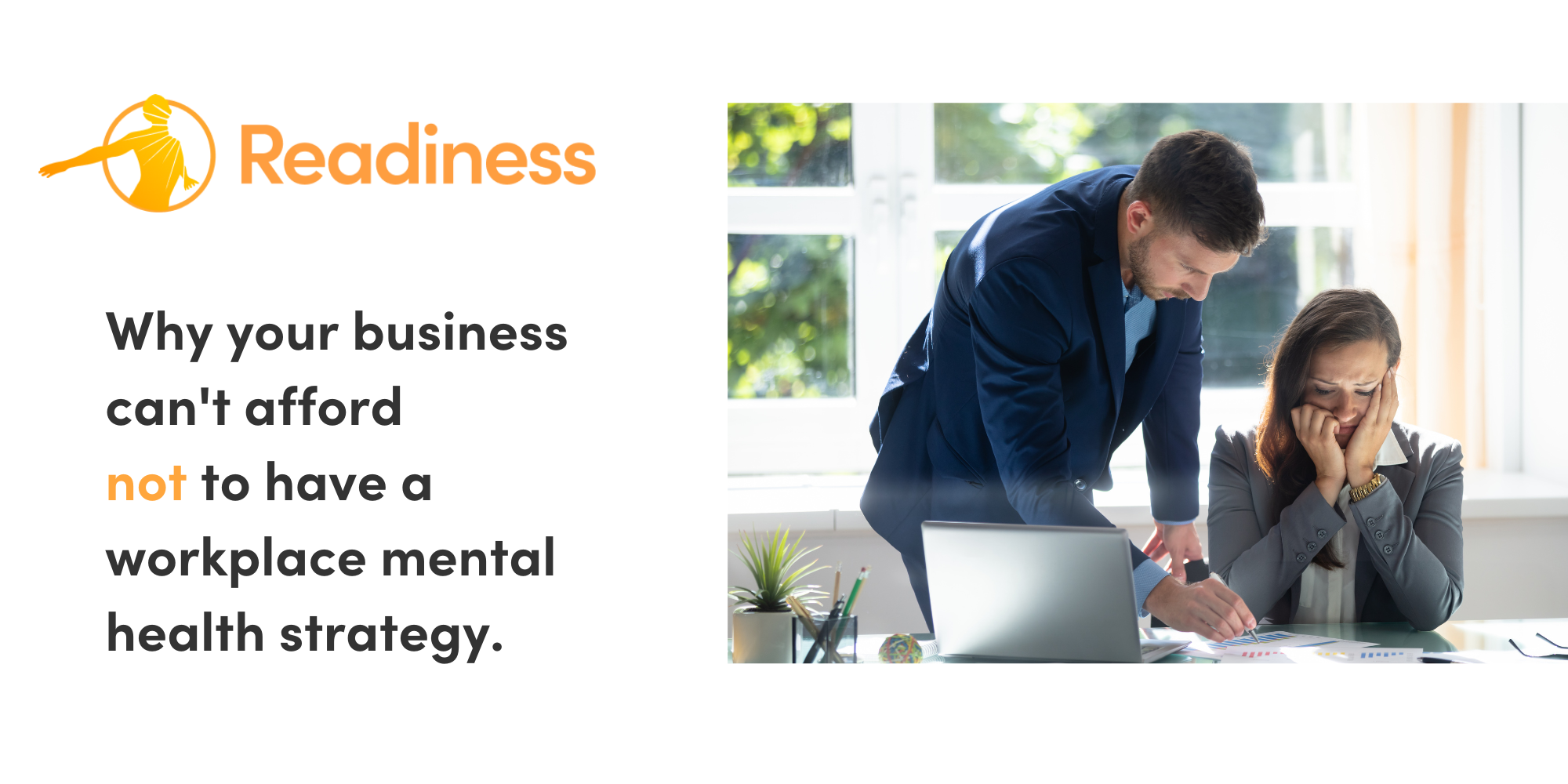Why your business can't afford not to have a workplace mental health strategy

Four reasons why it makes good business sense to implement a mental health program, before it's too late.

If you’re a business owner or CEO, you will be well versed in the responsibility to ensure a physically safe workplace – after all, no one wants a compensation claim. But, did you know, you also have a legal obligation to provide a psychologically safe work environment for your staff?
The Work Health and Safety Act (2011) requires businesses to ensure the health and safety of their workers, so far as is reasonably practicable. And, the act defines health to mean both physical and psychological health. But the obligation to provide a psychologically safe work environment is not as widely known.
Nor acted upon.Despite one in five employees reportedly taking time off work in the past 12 months due to feeling mentally unwell, wellbeing initiatives are often seen as a cost to the business, which can be hard to quantify. But, let’s be clear, investing in a mental health program is far less costly than a corporate fine – or even jail time!
In my observation, business leaders who are prioritising the mental health and wellbeing of their employees are streaking ahead. The flow-on benefits to their business include greater productivity, reduced absenteeism, reduced presenteeism, happy and loyal staff and becoming an employer of choice. The list goes on. But, perhaps most importantly, they understand that it’s morally the right thing to do.
So, if you’re ready to prioritise your employees mental health and wellbeing, read on to find out the four things you should know.
- Paul Francis, Readiness Co-founder and CTO.
Four things you should understand about putting a workplace mental health strategy in place.
1. Understand your legal obligation to provide a psychologically safe work environment.
-3.png?width=200&name=Untitled%20design%20(41)-3.png) While laws vary from state to state, they generally have comparable requirements for businesses to have a duty to protect workers from psychological and physical risks.
While laws vary from state to state, they generally have comparable requirements for businesses to have a duty to protect workers from psychological and physical risks.
The best way to do this is by implementing a workplace mental health and wellbeing strategy to eliminate or minimise risks to psychological health; monitor the health of workers and workplace conditions; and regularly consult with workers.
Under the Work Health and Safety Act you also need to provide a return to work policy that supports employees to come back or stayat work after experiencing a work-related mental health condition. This means providing a safe environment where psychological hazards are identified and controlled. You must understand workers’ compensation laws and how they place obligations on the employer.
2. Understand the cost of workplace mental health issues to your business.
-2.png?width=241&name=Untitled%20design%20(42)-2.png) According to Safe Work Australia, the most common mechanisms causing mental stress are reported as work pressure, work-related harassment and/or bullying, exposure to workplace or occupational violence, other mental stress, exposure to a traumatic event, a vehicle accident, being assaulted and sexual or racial harassment.
According to Safe Work Australia, the most common mechanisms causing mental stress are reported as work pressure, work-related harassment and/or bullying, exposure to workplace or occupational violence, other mental stress, exposure to a traumatic event, a vehicle accident, being assaulted and sexual or racial harassment.
The health burden of these consequences on employees – and therefore your business – can be devastating, including increased potential for mental health problems, heart conditions, certain types of cancer and substance abuse – to name a few.
Financially, the cost to businesses and the Australian economy are also significant. Each year, $543 million is paid in workers’ compensation for work-related mental health conditions. If you measure the impact of employee mental health conditions on businesses, the typical compensation payment per claim was$24,500, compared to $9,000 for other types of claims, and the typical time off work was 15.3 weeks compared to 5.5 weeks for all claims.
3. Understand the risks of not having a proper mental health strategy in place.
-2.png?width=274&name=Untitled%20design%20(43)-2.png) So, what’s the worst-case scenario if your workplace doesn’t provide adequate mental health support?
So, what’s the worst-case scenario if your workplace doesn’t provide adequate mental health support?
In September 2006, 19-year-old Brodie Panlock ended her life after enduring ongoing humiliating and intimidating bullying by her co-workers at a café in Hawthorn. Her death was a tragic reminder of the serious consequences that bullying can have on victims, their families and the community.
As a result, Brodie’s Law, Victoria’s anti-bullying legislation, was introduced in June 2011 and made serious bullying a crime punishable by up to 10 years in jail.
Following that, Victorian state government workplace manslaughter laws came into effect in 2019. This rules that negligent bosses can faceup to 20 years in jail and $16 million in fines over the suicide deaths of their workers. The laws cover deaths caused by mental injuries, including trauma from bullying or other forms of abuse, sustained on the job as well as accidents and illnesses caused by unsafe workplaces.
4. Understand how to provide a psychologically safe environment.
Remember, creating a mentally healthy workplace is a shared responsibility. All staff – from managers to employees – have a role to play. However, as a business leader, your obligations include identifying psychosocial hazards, assessing and controlling the risks, reviewing your control measures and intervening early, according to Safe Work Australia’s national guidelines, Work-related psychological health and safety
.A best practice approach to developing and sustaining a psychologically healthy workplace should focus on mental illness prevention and mental health promotion.
The good news, this is easily achieved with cost-effective preventative initiatives, such as the Readiness complete wellbeing platform. The scientifically-backed platform monitors for early risk signs through regular self-assessments and delivers tailored educational resources to improve self-directed wellbeing learning and growth. The platform also refers those in need to expert practitioners, if required.
There’s no doubt positive leadership that makes staff mental health and wellbeing a strategic priority can improve an organisation’s workplace health and safety performance, but it also reduces important business risks.
Remember, as a business owner or CEO, it’s your responsibility to take mental health seriously and make sure you adhere to your legal obligations to provide a psychologically safe workplace.
To find how Readiness can help your business meet the legal obligations to provide a psychologically safe work environment for your staff, visit: www.readiness.org.au

Paul Francis is a Co-founder and the Chief Technical Officer of Readiness - a complete wellbeing platform for business and schools.




